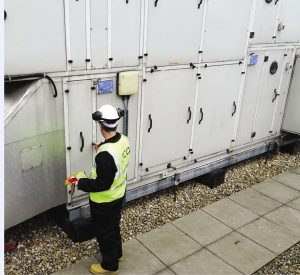 Throughout the current crisis the maintenance of hard FM services has remained crucial. Tom Absalom, Managing Director at JCA describes how maintenance and engineering services have continued in times of COVID-19
Throughout the current crisis the maintenance of hard FM services has remained crucial. Tom Absalom, Managing Director at JCA describes how maintenance and engineering services have continued in times of COVID-19
The pandemic caused by the global spread of the Coronavirus has presented immense challenges to society, and within that the responsibilities and activities of those operating commercial offices and other places of work. As an engineering company, JCA has been having to adjust to a new, evolving set of requirements, some of which are not supported by industry guidelines but based on our own learning and interpretation, such is the speed with which the impacts of the pandemic have unfolded.
The government’s advice was, in the first instance, quite clear. Work from home if you can, if you cannot work from home then go to work. This affected our clients in different ways. Those operating commercial offices that supported a workforce that could viably work from home went from bustling working environments to an eerie stillness quite literally overnight. The support of those buildings from a building engineering perspective could not, however, stop.
MAINTAINING BUILDINGS IN TIMES OF LOW OCCUPANCY
The requirements for maintenance activities continued throughout the initial lockdown phase, tasks such as those detailed in SFG20(i) Red covered the statutory requirements of the building systems. Building owners were advised to liaise with their insurers to understand what levels of building attendance were required to maintain their insurance cover. Where clients took a more long-term view on building occupation, we have been able to refer to the SFG30 Mothballing and Reactivation standard(ii) recently updated by BESA(iii) (Building Engineering Services Association).
In addition to the statutory requirements for maintenance continuing, the hugely reduced occupancy for commercial offices required further considerations such as the secondary risk of legionella caused by stagnation within building water systems. Increased maintenance regimes were put in place to increase levels of flushing, and water storage capacity was reduced to ensure a constant turnover of water. Testing was increased to ensure that water quality was monitored and maintained. These activities maintained the safety of the water system but also mitigated the risk of extensive remedial works when buildings were put back into operation. Another element that was common across our affected client base was the adjustment of environmental control systems to make sure that the building efficiency was optimised for the occupancy level.
 PREPARING FOR THE RETURN OF STAFF TO A COVID SECURE WORKPLACE
PREPARING FOR THE RETURN OF STAFF TO A COVID SECURE WORKPLACE
The return of staff to their place of work represented a significant challenge for our hard FM teams and we played a role supporting our client’s staff communications. Heightened levels of staff anxiety induced by the pandemic had to be addressed with clear messaging that was, as far as possible, supported by visual change. Signage, screening, and sanitiser stations were all obvious but impactful.
Building services in the commercial office have generally been deemed successful if occupants are unaware of their presence and the effect they have providing a comfortable working environment. The benefits of increased ventilation rates were well communicated during the early months of the pandemic, as was the recommended reduction of recirculating air movement systems, with ventilation to be prioritised over thermal comfort and energy efficiency. The REHVA (Federation of European Heating, Ventilation and Air Conditioning Associations) COVID-19 guidance document(iv), originally generated in March and updated in April and most recently in August identifies that ventilation is the primary engineering control available to prevent airborne infection beyond 1.5m. Within 1.5m social distancing is more effective.





